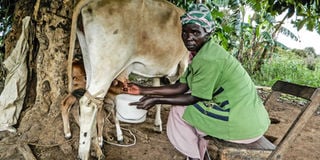Locals want Nusaf III in all conflict-affected areas

Beneficiary. A woman milks a cow which she bought after benefiting from Nusaf III at Ayat B Village, Anwangi Parish in Nambieso Sub-county, Apac District, on October 20, 2018. PHOTO BY BILL OKETCH.
What you need to know:
- At least 1,000 people have benefited under the two Nusaf III components in Minakulu. However, locals say instead of benefiting only a selected few areas, the rebuilding programme should be extended to all post-conflict affected areas.
- In Oyam, there are a total of 185 sub-projects which have already been supported under Nusaf III, with a total of about Shs5.4b since the inception of the third phase of the rebuilding programme.
Residents of Minakulu Sub-county in Oyam District have demanded that the phase three Northern Uganda Social Action Fund (Nusaf III) be extended to the entire post-conflict affected communities.
The residents say the third phase of the rebuilding programme would help the community to rebuild homes and lives after the Lord’s Resistance Army (LRA) war.
“There are a lot of challenges that we are still facing as a result of the two-decade conflict and without the support from Nusaf, there is no way we are going to rebuild our homes and lives,” Ms Hellen Alunyo of Owinyku Village, Atego Parish, said.
Mr Lawrence Otiti, an independent budget monitor of the Apac Anti-Corruption Coalition, concurred.
Challenges
“Most community access roads are still very bad and because of this, the community cannot easily access market for their produce, schools and health centres and many households are still very poor,” he said.
Ms Grace Ayugi, the Minakulu community development officer, noted that the demand for Nusaf III is overwhelming because of its success stories.
She said those who benefited from the project have built fairly good houses, bought or hired more land for production, established retail businesses and acquired household assets.
Unlike other redevelopment projects, Nusaf III requires beneficiaries to organise themselves in groups that engage in market driven enterprises, the Nusaf facilitator, Mr Isaac Newton Elwa, explained.
The beneficiaries are guided to produce and sell their produce.
“The groups must also engage in savings. They must save as a group, lend to each other, borrow, keep records and meet every week,” he told a meeting organised by the Apac Anti-Corruption Coalition at Minakulu Town Council on Monday.
He also assured the community that Nusaf III would cover the entire post-conflict communities of northern Uganda.
Currently, the government, through the Office of the Prime Minister, is using “watershed approach” to implement Nusaf III in the north.
A watershed is a water drainage or catchment area in which most communities settled historically.
Watershed approach is about concentrating and integrating development resources in a geographical sub-division called a “watershed.”
This approach enables the project to concentrate resources in order to achieve a critical mass of development, but also at the same time bring about a positive environmental impact within the watershed.
Also, watersheds can take up several villages.
In Minakulu Sub-county, the implementation of the programme is taking place under Myene Watershed. The intervention covers 10 villages in the two parishes of Opuk and Kulu-Abura.
So far, 18 sub-projects have been formed and funded under the two components of Labour Intensive Public Works (LIPW) and Livelihood Investment Support (LIS).
At least 1,000 people have benefited under the two Nusaf III components in Minakulu. However, locals say instead of benefiting only a selected few areas, the rebuilding programme should be extended to all post-conflict affected areas.
In Oyam, there are a total of 185 sub-projects which have already been supported under Nusaf III, with a total of about Shs5.4b since the inception of the third phase of the rebuilding programme.



